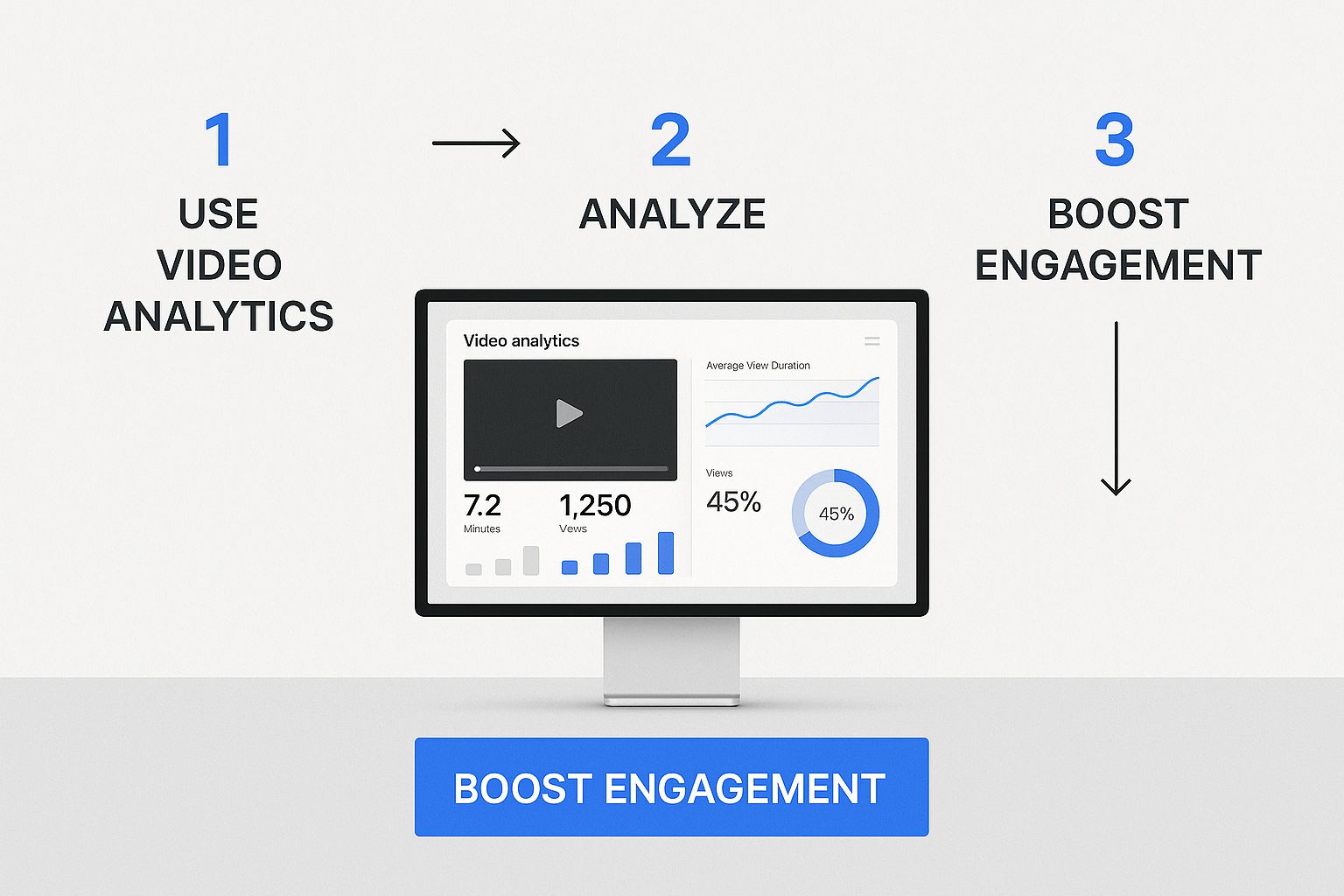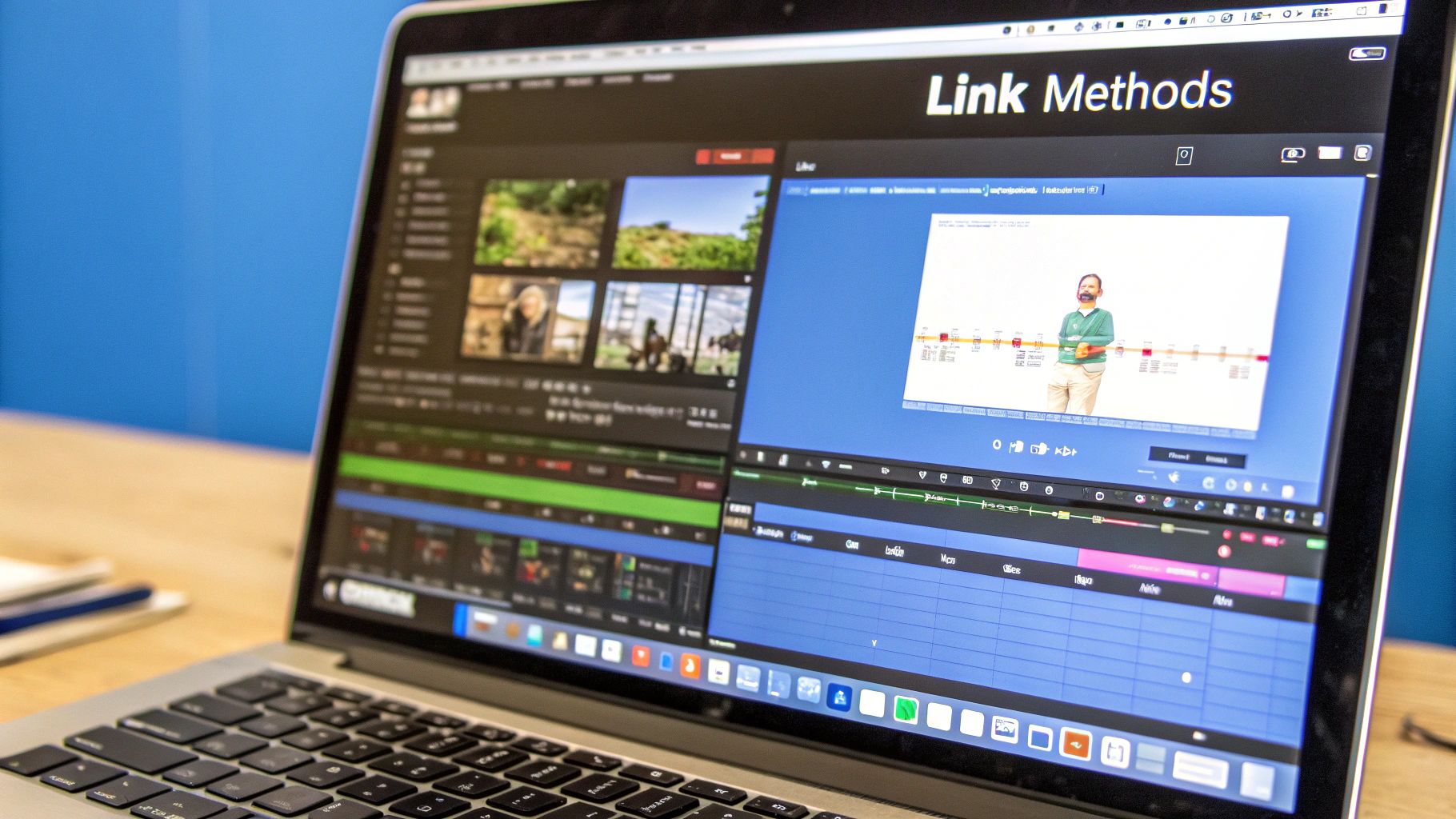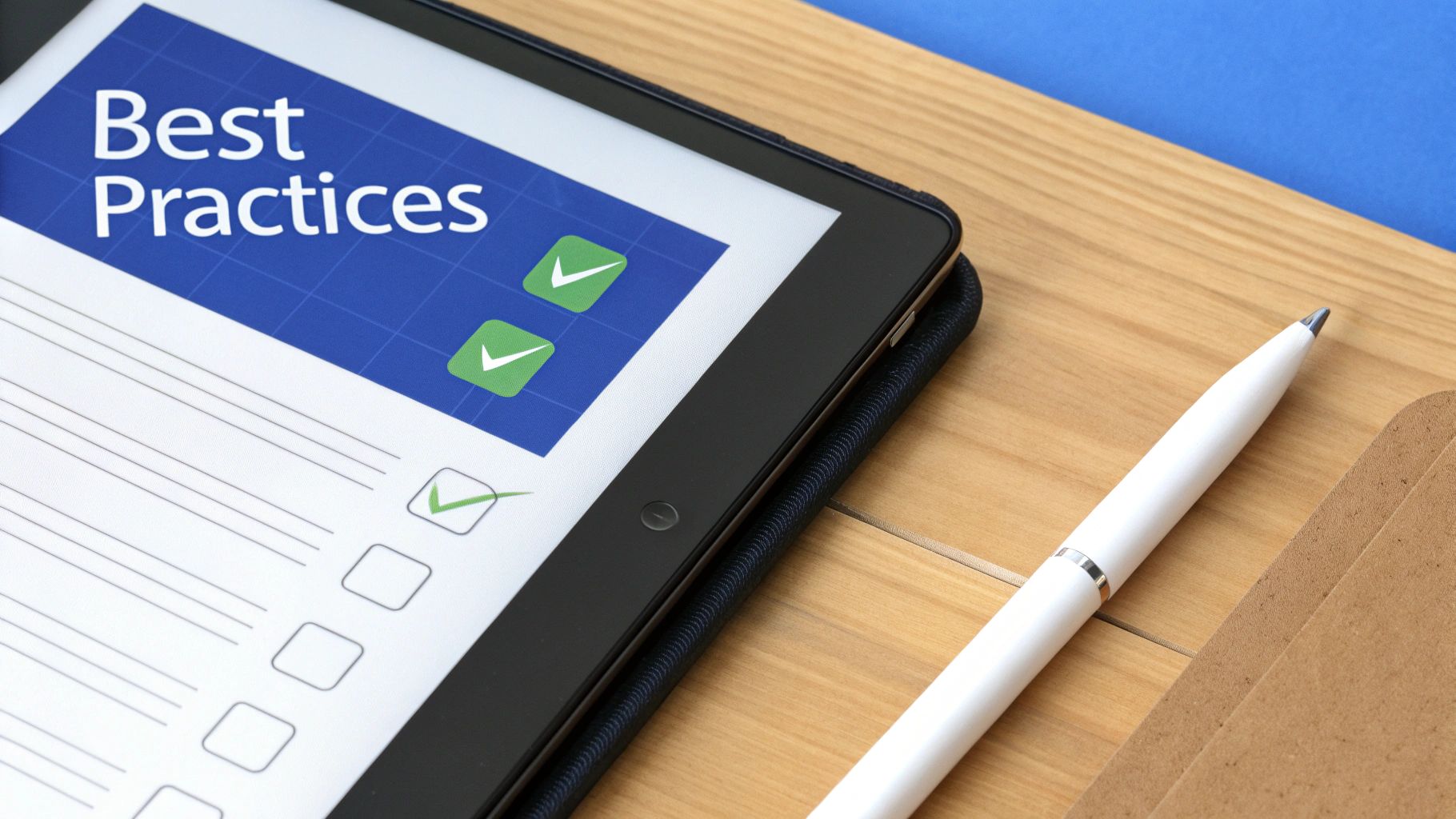
Learn how to add links to video to transform passive viewers into active customers. This guide covers actionable strategies for driving traffic and conversions.
Static video is essentially a one-way street. If you really want to connect with your audience, you have to give them a way to interact. That's where adding links to your video comes in—it turns someone just watching into an active participant. This isn't just a cool trick; it's a completely different way of thinking about the customer journey.
Why Interactive Video Is No Longer Optional
The old strategy of hitting "publish" and just hoping for views is a thing of the past. Effective marketing today is a two-way conversation. When you add links to your video, you’re giving viewers the power to act on their interest right away.
This could be anything from clicking a hotspot to see product details, filling out a form to join a webinar, or even booking a demo—all without ever leaving the video player.
Moving Beyond Passive Viewing
The whole point is to close the gap between a viewer's interest and their next step. Every second someone has to spend looking for a "learn more" link or navigating to a different page is a chance you'll lose them. By putting clickable links right inside the video, you get rid of that friction and keep their attention locked in.
This isn't just a video trend, either. The move from passive consumption to active participation is happening everywhere online. For example, the principles behind creating an interactive website are based on the same idea of keeping users engaged.
With the sheer amount of video out there, making yours interactive is how you stand out. Projections show that video will make up an incredible 82% of all global internet traffic by 2025. You can dig deeper into these video marketing trends and statistics to see the full picture. In a sea of content, a static video is just noise. An interactive one starts a real conversation.
Key Takeaway: An interactive video isn't just another marketing asset—it's a conversion engine. It gives your audience a clear path to engage, learn more, and ultimately convert, all from a single, compelling experience.
Driving Tangible Business Results
Embedding clickable elements brings real, measurable benefits that you can see on your bottom line. You're no longer stuck with basic metrics like views and watch time. Instead, you're tracking clicks, leads, and even sales that come directly from the video itself. This gives you a crystal-clear way to prove your return on investment.
A quick look at the data shows just how powerful this shift can be.
Interactive vs Static Video Performance
| Metric | Static Video Performance | Interactive Video Performance |
|---|---|---|
| Click-Through Rate | Low (requires off-screen CTA) | High (in-video CTAs) |
| Conversion Rate | Moderate | Significantly Higher |
| Viewer Engagement | Passive viewing | Active participation |
| Data & Insights | Basic (views, watch time) | Rich (clicks, choices, paths) |
The numbers don't lie. Interactive videos consistently outperform their static counterparts by making the viewer a part of the story.
The main advantages really boil down to a few key things:
- Higher Conversion Rates: Placing your call-to-action right at the moment a viewer is most interested is a game-changer. You capture their intent when it's strongest, which naturally leads to more sign-ups and sales.
- Deeper Engagement: When people can click and explore, they stick around longer. This active participation boosts how long they watch and makes your brand far more memorable.
- Valuable Data Collection: Tracking what people actually click on gives you incredible insight. You learn exactly what parts of your message are resonating, which helps you make your next video even better.
Your First Steps with Interactive Video Tools
Jumping into a new platform can feel a bit much at first, but you'll find that when you add links to your video with a tool like VideoQi, the process is surprisingly straightforward. The first thing you'll always do is get your video into the system.
You can kick off a new project in two ways: either upload a video file directly from your computer or just paste in a link from a platform like YouTube or Vimeo. I personally love this flexibility because it means I can enhance videos I've already published or start completely from scratch. Your main goal here is to get the video loaded onto the timeline editor—this is your command center for adding all those cool interactive features.
This initial setup is really just about getting your bearings. Once your video is in, you'll see it in the main preview window with a timeline scrubber underneath, much like any standard video editor. Before you even think about adding links, my advice is to play the video and drag the playhead around the timeline. Get comfortable pinpointing exact moments, because that precision is what will make your interactive elements feel seamless later on.
Finding Your Way Around the Editor
The editor is where the magic happens. Think of it as your creative canvas. On one side, you'll typically find your library of interactive elements—things like buttons, hotspots, and lead capture forms. On the other side, you'll see all the properties you can tweak, like colors, text, and timing.
For anyone just starting out, here's my go-to tip: just add one element. Don't worry about making it perfect. Throw a simple button on there and just poke around its settings. This kind of low-pressure experimentation is honestly the fastest way to get comfortable with any new interface.
This dashboard gives you a glimpse of how a clean workspace helps you focus on what matters—boosting engagement with interactive features.

The real takeaway here is that a well-designed tool can take complex data and make it easy to digest, which makes optimizing your video's performance a breeze.
Once you’ve mastered these first steps, you're ready to create some truly dynamic viewing experiences. For a deeper look into the creative side of things, check out our guide on how to make interactive video for more advanced strategies.
Designing Hotspots That Get Clicks
So, you’ve uploaded your video to the editor. Now comes the fun part—turning passive viewers into active participants. Let's be honest, just slapping a generic button on your video and hoping for the best is a recipe for disappointment. If you want people to actually click, your interactive elements need to be thoughtfully designed and placed.
It’s about more than just a link. You can craft anything from a subtle text overlay offering a bit more context to a bold, can't-miss-it call-to-action (CTA) button that feels like a natural extension of your video. The real trick is making your links feel helpful, not like a pushy sales pitch.
Making It Your Own: Customization and Branding
The most effective interactive elements blend in seamlessly. They should look and feel like they belong in your video. That's exactly why VideoQi gives you a ton of customization options—so you can match every hotspot to your brand's unique identity. You're not just adding a button; you're weaving an interactive thread into your visual story.

Here are a few small tweaks I've seen make a huge difference:
- Dial in Your Colors: Use your brand’s exact hex codes for buttons and text. It keeps the visual experience consistent and professional.
- Play with Transparency: Try lowering a hotspot's opacity. This makes it feel more integrated with the video, serving as a subtle nudge rather than a loud interruption.
- Add a Touch of Animation: A gentle pulse or a soft slide-in effect can be just enough to catch the viewer's eye at the perfect moment, without being obnoxious.
These little details really do matter. They can be the difference between a link that gets completely ignored and one that drives real engagement. For a deeper dive, our guide on embedding links in video is packed with more practical examples.
It's All About Timing: Strategic Placement
Where and when your link appears is just as crucial as its design. Bad timing feels like a disruptive ad. Great timing feels like you're reading the viewer's mind. The whole point is to make their experience better, not to get in their way.
Think about a product demo video. When should the "Shop Now" hotspot appear? The second the product is being shown and discussed, of course. This kind of contextual timing is incredibly powerful. You're satisfying the viewer's curiosity right when it peaks, which dramatically boosts the chances they'll click.
My Two Cents: Don't wait until the very end to drop your most important links. I've found that placing a key CTA somewhere around the 50-70% mark in the video often works wonders. You catch people at their peak engagement, just before their attention might start to wander.
Businesses are pouring more money into video than ever before, with global video ad spending expected to reach a staggering $241.9 billion by 2028. This massive investment shows why getting every detail right—including your CTAs—is non-negotiable. By carefully designing and placing your links, you can make sure your video budget delivers tangible results.
Advanced Strategies to Maximize Engagement
Okay, you've got the hang of adding basic links to your videos. Now it's time to really open up the throttle and see what's possible when you move beyond simple CTA buttons. We're talking about turning a passive viewing session into a dynamic, two-way experience that does some serious heavy lifting for your goals.
Think of it as the difference between giving a monologue and having a conversation. Instead of just pushing information out, you're about to invite your viewers to lean in, participate, and guide their own journey.
Creating Branching Scenarios
This is one of my favorite features because it’s so powerful. Imagine you've created a product demo. Instead of walking through every single feature in a linear fashion, what if you could ask the viewer, "What do you want to see first? Feature A, B, or C?" That's the core of a branching video.
By setting up interactive choice points, you let people build their own adventure. A corporate training video could let an employee choose a path based on their department. A sales video could let a prospect jump directly to the pricing or a specific use case they care about. It’s a game-changer for personalization.
This turns your video into a self-segmenting funnel. For some great, real-world examples of how this works in advertising, check out our guide on creating an effective interactive video ad.
This isn't just about showing a video; it's about building an experience. When viewers can choose their own adventure, their engagement and information retention skyrocket because they are actively shaping their own narrative.
Generating Leads Directly in Your Video
Here's another incredibly practical strategy: use your video as a lead generation tool. You can gate premium content right inside the player with a simple form.
For example, you could tease a valuable checklist or an exclusive interview, then prompt the viewer for their email to unlock the rest of the content. They get instant value without ever having to navigate to a separate landing page, which means less friction and higher conversion rates. You capture a qualified lead right at the moment they're most engaged.
And don't stop there. Think about gathering direct feedback. A few powerful tools to weave into your videos include:
- In-Video Quizzes: A fantastic way to test comprehension in training modules or to reinforce key selling points in a fun, engaging way.
- Live Polls: Want instant feedback on a new feature or marketing concept? Pop a poll into your video and get real-time data from your most engaged viewers.
When you start using these advanced strategies, you’re no longer just talking at your audience. You’re building a genuine, interactive relationship with them.
Measuring the ROI of Your Interactive Videos

Adding links to a video is one thing, but understanding what happens after someone clicks is where the real value lies. If you're not measuring the impact of those interactions, you're essentially flying blind. Good analytics, on the other hand, let you prove the value of your work and make smart, data-backed decisions to improve your next video.
It’s time to move past surface-level stats like view counts. Interactive video analytics give you a much richer, more detailed picture of how your audience actually behaves. You can finally get answers to the big questions: Which calls-to-action are resonating? Where in the video are people most engaged and ready to take the next step?
Key Metrics You Should Be Watching
Your analytics dashboard in a platform like VideoQi is your mission control for proving ROI. Instead of just seeing how long people watched, you get a full story about their journey.
Here are the numbers I always keep a close eye on:
- Hotspot Click-Through Rate (CTR): This is the big one. It’s the percentage of viewers who saw a link and actually clicked it. A high CTR on a "Shop Now" button is a powerful indicator of genuine buying interest.
- Engagement Heatmaps: These are fantastic. A heatmap visually shows you which parts of your video people watch over and over and which parts they skip. This is gold for figuring out the perfect moment to drop in a link or CTA.
- Conversion Data: This is where you connect the dots between a click and a business goal—like a completed sale, a newsletter signup, or a booked demo. This metric is how you tie your video efforts directly to revenue.
Think of it this way: A low CTR isn't a failure. It's an opportunity. It’s your data telling you to try a different button color, change the timing of the hotspot, or test new button text. This is how you create a feedback loop for constant improvement.
Tying Clicks to Dollars
As video becomes a bigger part of every marketing budget, you have to be able to show its financial return. To get a handle on the dollars and cents of your campaigns, a dedicated tool like a Social Media ROI Calculator can help you frame the conversation and calculate the impact.
Looking ahead, it's clear this isn't just a trend. By 2025, 89% of businesses were already using video as a key marketing tool. With so many people in the game, the pressure to prove ROI is only going to get more intense. By tracking the right metrics when you add links to video, you can confidently show exactly how your work is contributing to the bottom line.
Of course! Here is the rewritten section, designed to sound natural, human-written, and expert-led.
Still Have Questions About Adding Links to Video?
Even with a tool like VideoQi in your corner, stepping into interactive video for the first time usually brings up a few questions. That’s perfectly normal. Let's walk through some of the most common things people ask when they're ready to add links to video content.
Can I Just Add These Links to My YouTube or Instagram Videos?
This is probably the biggest point of confusion I see. The short answer is no, not in the way we're talking about here.
YouTube does give you some basic tools like end screens and info cards, but you can't place a fully custom, clickable hotspot right on top of a product in your video. To get that kind of pinpoint control, you need a dedicated interactive video platform like VideoQi. You'd then take that enhanced video and embed it on your website, landing page, or in your email campaigns.
Social media platforms like Instagram and TikTok are even more locked down. They simply don't support in-video clickable links for standard organic posts. Your best bet there is to direct people to a "link in bio," use a link sticker in a Story, or run paid ads that have built-in CTA buttons.
Won't Interactive Links Just Annoy My Viewers?
They can, but only if they're done poorly. A clunky, irrelevant link that pops up at the wrong time? Yeah, that's annoying. But a thoughtfully placed link that helps the viewer is a different story entirely.
Imagine watching a product demo and being able to click directly on the feature being discussed to learn more. That's not an interruption; it's a convenience. It shows you're thinking one step ahead of your audience.
The secret is context. A great interactive link feels like a natural part of the conversation, not a random ad shoved in your face. When you add links to video with the viewer's journey in mind, you're making the content more valuable, not less.
The goal is to be helpful, not disruptive. Think of it as a quiet guide, not a loud salesperson.
What's the Single Most Important Metric to Track?
Everyone’s goals are a bit different, but if I had to pick one universal starting point, it would be the Click-Through Rate (CTR) on your links. This simple number tells you exactly how many people are actually raising their hand and engaging with what you've put in front of them. It's the purest signal of interest.
Once you've got a handle on CTR, you can start digging deeper based on your specific campaign goals.
- Selling a product? The ultimate metric is sales conversions tied directly back to a video click. That's your ROI.
- Generating leads? Your north star is the form submission rate. How many viewers turned into actual leads?
- Running a training module? Look at quiz scores and video completion rates to see if people are actually learning.
Ready to stop talking at your audience and start a conversation? With VideoQi, you can add clickable hotspots, lead forms, and even branching choices to your videos in minutes. Explore VideoQi's features and see how it works with a free trial!


